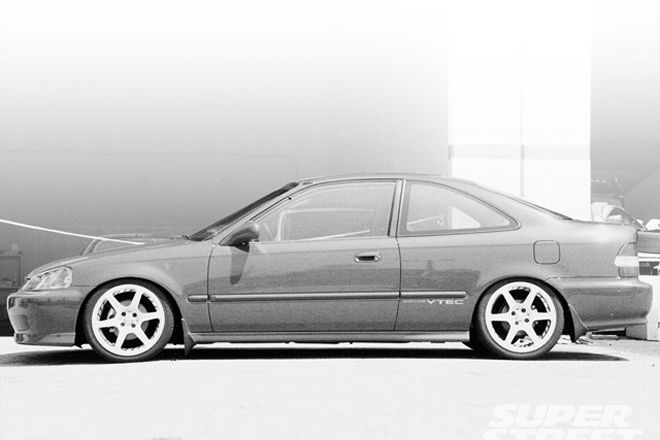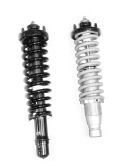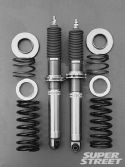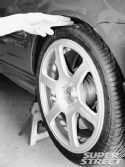Coilovers are perhaps one of the best combos to spring onto the scene since oversized wheels and the matching rubberband tires came out. Not quite as tasty as macaroni and cheese, but still one of the best. Now you know that they’re cool and all, but do you really know what they’re used for? Kinda, and kinda-not, right? They make it easier for me to lower or raise my car whenever I want. That’s true, but that shouldn’t be the only reason you add coilovers to your ride. Convenience is one thing, but once you open your eyes to the performance and handling aspect of coilovers, you’ll see a whole new world. The following is a guide that we’ve compiled with the help of two of our industry’s leaders in suspension technology. Eddie Lee of Mackin Industries and Jonathan Spiegel of The Progress Group both have great in-depth knowledge about suspension components and welcome you to contact them with any further questions or comments.
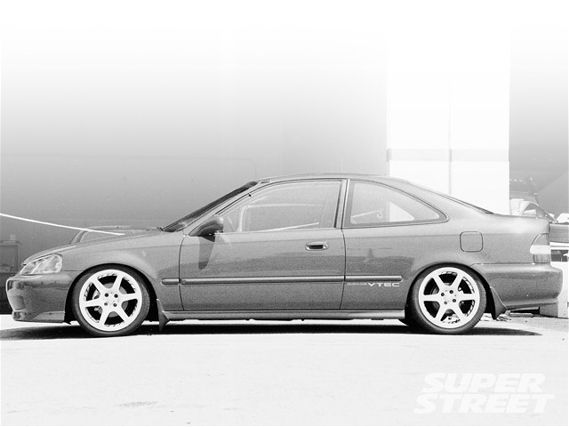 |
Coilover Suspension Systems Explained - Keep It On The Downlow
|
Coilover Suspension Systems Explained - Keep It On The Downlow
First things first. Springs, shocks, linkage, and the bushings make up a car’s suspension. The springs support the weight of the car and absorb vehicle load while traveling over bumps or during cornering. The shocks help to damp out, or decrease, the amplitude of any unwanted spring motion in the suspension. The linkage helps to control the comparative motion of the wheels to the vehicle body. The bushings work in conjunction with the linkage by acting as pivot points.
A coilover suspension is a suspension system that allows the adjustment of the spring perch by locating the spring over the shock. The spring perch is the lower support area where the spring sits. An adjustable spring perch, found on a coilover kit, allows the vehicle ride height to be raised or lowered at the owner’s discretion according to how he would like his car to sit in relation to the ground. Stock suspensions only feature springs that fit directly over the shocks without an adjustable spring perch, making them a non-adjustable item. Both stock and coilover suspension kits can use adjustable damping gas shocks as a means to adjust the ride comfort, however, it is recommended that you use a shortcase shock and rod in conjunction with your lowering springs. Eddie Lee of Mackin Industries says that this is quite beneficial because the shock is shortened for correct spring height, while maintaining OEM-like specs. Matching a lowered shock with a lowering spring keeps the ride stable and prevents the factory shock from blowing out by using a shortened case.
There are two types of coilover systems that we have seen on the market. The first is the single-threaded shock casing that comes with a locking collar which spins on the sleeve. This setup provides ride-height adjustability with a few simple turns of the collar and a locking key. Companies like HKS and Tanabe produce coilover kits that feature dual-spinner locking collars (one for locking, one for adjusting), which provides a safety locking mechanism to avoid any slippage due to the locking collars’ potentially becoming unlocked while driving.
Coilovers are also a great asset in all aspects of racing. At the dragstrip, coilovers are beneficial in helping a racer to dial-in his car perfectly by balancing out weight transfer at all four corners, thus aiding in gaining maximum traction. The same applies to road racing, where coilovers provide adjustability in a car’s weight distribution or ride height. For daily driving and show purposes, coilovers are perfect for slamming a car right down to the ground for an afternoon at a NIRA car show or for cruising the city during a happening Friday evening. In case the driver feels that the car may be too low, the ride height can be adjusted to accommodate any road conditions, in which case, the damping may also be adjusted provided adjustable shocks are installed.
Another feature to highlight when using coilovers for daily driving is the ride stiffness felt by using such a suspension system. This is due to the spring rate of the coilover springs, which vary depending on which spring you decide to use. The higher the spring rate, the less likely you are to bottom out. However, the ride will be harsh. This leads us back to choosing a shortcase shock and rod when purchasing coilovers. The shortened-casing high-performance shocks will work better with the stiff springs, and your ride quality will be determined by the spring design. And what about upper pillow mounts? These replace the shock hats, eliminating the use of the factory rubber bushings and stiffen up your suspension even further, while offering more precise handling or even the ability to adjust the camber.
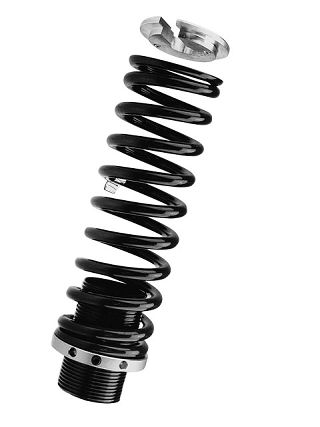 |
There are a couple different types of coilover systems. Pictured is a coilover from Ground Control. The parts that make it different from a normal suspension system are the threaded shock sleeve and the collar that spins on the sleeve. The combination of the two equates to an adjustable spring perch, and they allow adjustment of a car’s ride height.
|
There are a couple different types of coilover systems. Pictured is a coilover from Ground Control. The parts that make it different from a normal suspension system are the threaded shock sleeve and the collar that spins on the sleeve. The combination of the two equates to an adjustable spring perch, and they allow adjustment of a car’s ride height.
Now that you’ve got the low-down on coilover suspensions, it’s up to you to decide which system is best for you. Remember what the key roles of your suspension will be and determine whether or not it is suitable for your type of driving and/or racing.

